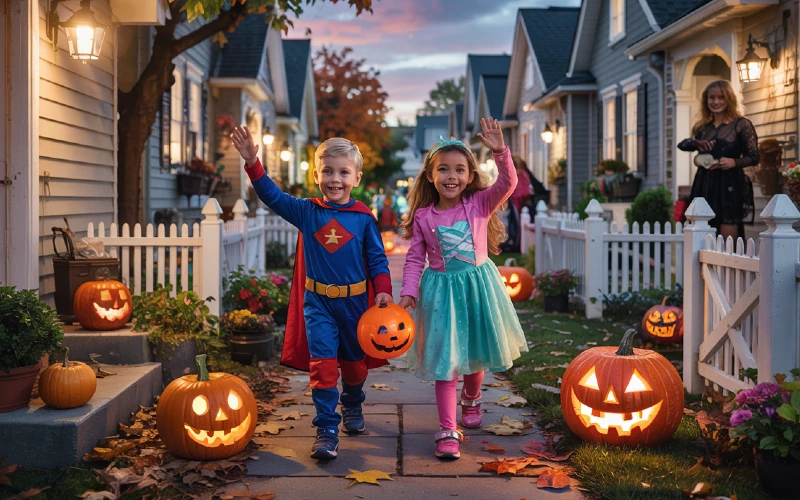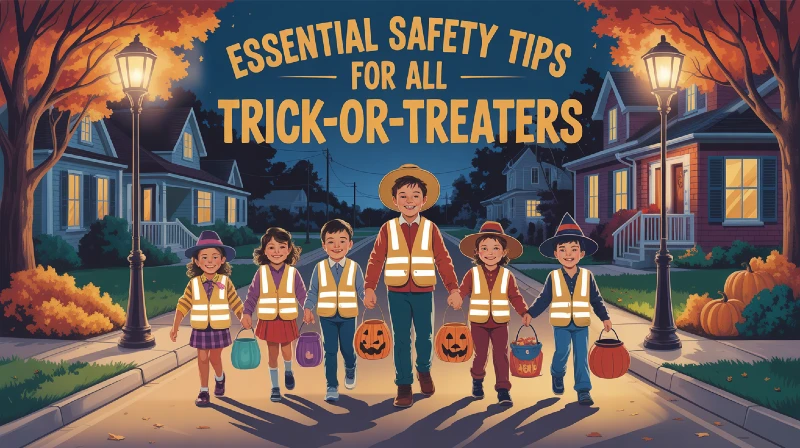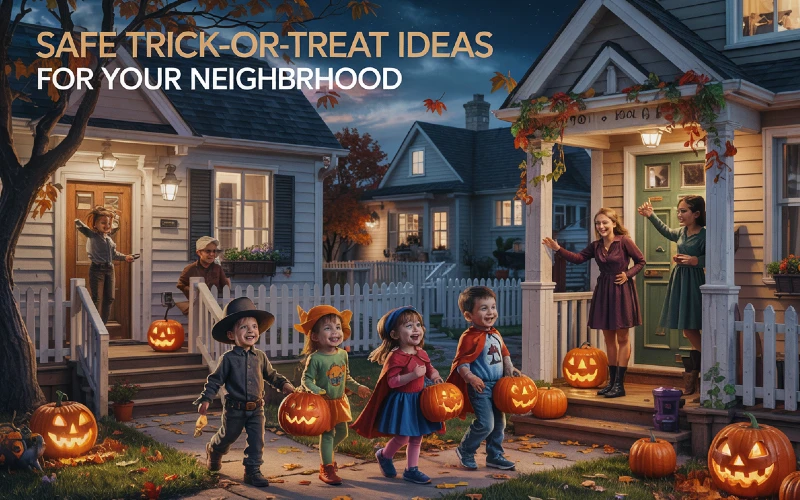7 Safe Trick-or-Treat Ideas for Your Neighborhood
Why Safety Should Be a Priority on Halloween
Halloween is one of the most anticipated nights of the year—filled with costumes, candy, creativity, and community spirit. But while it’s a time for celebration, it’s also a time to stay alert. With so many children outdoors after dark, safety becomes just as important as fun. From unlit streets and masked strangers to food allergies and the potential for accidents, Halloween carries risks that shouldn’t be overlooked.
Taking safety seriously doesn’t mean canceling the fun—it means protecting it. Ensuring that kids are visible, supervised, and aware of their surroundings can help prevent mishaps and create a more enjoyable experience for everyone.
The good news? Many communities are already finding smart ways to celebrate safely. Whether it’s a well-organized trunk-or-treat, a neighborhood parade, or virtual festivities, families and local groups are proving that with a little creativity and planning, Halloween can be both magical and mindful.

Essential Safety Tips for All Trick-or-Treaters
Before we explore creative Halloween activities, it’s important to start with a few core safety practices. These foundational tips ensure that every child—no matter where or how they celebrate—can enjoy the night safely and confidently.
- Stay Visible: As night falls, visibility is key. Equip kids with glow sticks, flashlights, or LED bracelets, and add reflective tape to costumes, shoes, and treat bags to make them easily seen by drivers.
- Supervise Young Children: Children under the age of 12 should always be accompanied by a trusted adult or older sibling. Even older kids should travel in groups, stick to familiar routes, and check in regularly.
- Inspect All Treats: Before indulging, inspect all candy and treats for any signs of tampering. Look out for opened wrappers, unfamiliar brands, or homemade items from strangers. For children with food allergies, read labels carefully or opt for pre-approved treats.
- Stay on the Sidewalk: Stick to sidewalks whenever possible and use crosswalks when crossing the street. Never assume a driver sees you—make eye contact or wait for cars to stop completely.
- Avoid Masks That Obstruct Vision: Choose face paint over full-face masks when possible, or ensure that masks don’t block peripheral vision, especially near traffic.
These simple but essential precautions can go a long way in ensuring a fun, safe, and stress-free Halloween for all trick-or-treaters.

7 Safe Trick-or-Treat Ideas for Your Neighborhood
1. Organize a Trunk-or-Treat Event
Transform a parking lot into a festive, candy-filled wonderland. Families decorate their vehicle trunks in spooky or playful themes, dress in costumes, and distribute candy from their cars.
Why it’s safer:
- Limited vehicle traffic and a secure location
- Centralized setup allows for better adult supervision
- Reduces wandering through unfamiliar neighborhoods
Extra Fun Tip: Run a “Best Decorated Trunk” contest to engage all participants.
2. Host a Neighborhood Block Party
Close off a street and host a community Halloween bash. With music, food, games, and costume contests, block parties bring neighbors together for a festive evening in a controlled environment.
Why it’s safer:
- Familiar setting with known participants
- Reduced vehicle access ensures safer foot traffic
- Group supervision makes monitoring easier
Activities to Include: Pumpkin bowling, a DIY photo booth, face painting, and themed dance-offs.
3. Create a Haunted Path or Candy Trail
Design a guided walking path through a local park, backyard, or series of yards with decorated checkpoints where adults distribute candy.
Why it’s safer:
- Keeps kids moving along a set route
- Supervision at every stop prevents wandering
- Encourages a fun, shared experience
Enhancement Ideas: Use fog machines, motion sensors, and eerie sound effects to boost the excitement.

4. Set Up Candy Stations at Driveways
Encourage homeowners to set up Halloween-themed tables or booths at the end of their driveways, turning each into a mini candy station.
Why it’s safer:
- Keeps trick-or-treating outdoors and well-lit
- Minimizes trips up stairs or onto dark porches
- Supports social distancing, if necessary
Bonus Suggestion: Offer allergy-friendly and non-candy treat options clearly labeled for parents to identify.
5. Arrange a Trick-or-Treat Parade
Coordinate a neighborhood parade where kids walk or ride bikes in costume along a planned route. Parents walk alongside to supervise, and neighbors cheer them on.
Why it’s safer:
- Children stay together in a supervised group
- Reduced chance of traffic-related accidents
- Adds a sense of celebration and visibility
Theme Ideas: Pirates & Mermaids, Superheroes, Classic Monsters, or Movie Characters.
6. Deliver Treat Bags to Kids’ Homes
For a no-contact approach, residents can assemble treat bags and deliver them to neighborhood children’s homes earlier in the day.
Why it’s safer:
- Eliminates crowding and reduces contact
- Allows time for parents to inspect treats in advance
Creative Add-On: Include jokes, coloring sheets, glow sticks, or mini activity books to make each bag extra special.
7. Host a Virtual Trick-or-Treat Party
Move the magic online by hosting a virtual costume contest, trivia games, or scavenger hunts. Send out small prizes or treats by mail to participants.
Why it’s safer:
- Ideal for immunocompromised families or remote participants
- Completely eliminates in-person risk
Fun Features: Use custom virtual backgrounds, breakout rooms for games, or vote on costumes for prize categories like “Most Creative” or “Funniest.”
FAQs About Safe Trick-or-Treating
Is trunk-or-treating safer than traditional trick-or-treating? Absolutely. Trunk-or-treating takes place in well-lit, supervised environments like school or church parking lots. It reduces foot traffic in unfamiliar areas and helps parents keep a close watch.
How can I make my home safe for trick-or-treaters? Start by clearing walkways of any tripping hazards, such as cords, decorations, or wet leaves. Keep your porch well-lit, secure pets indoors, and consider offering allergy-friendly treats with clear labels.
What should kids carry with them while trick-or-treating? Kids should carry a flashlight or glow stick, their treat bag, and if old enough, a phone for emergencies. Adding a contact card with their name and your phone number is a smart precaution for younger children.
How do I plan a safe neighborhood Halloween event? Begin with a clear plan and involve neighbors early. Use flyers, social media, or neighborhood apps to communicate details. Recruit volunteers to monitor key areas, post visible signage, and provide safety stations with first-aid or extra flashlights.
What are good alternatives to traditional candy? There are many exciting options beyond candy—try stickers, temporary tattoos, mini coloring books, small puzzles, bubbles, or glow sticks. These non-food items are perfect for kids with allergies or dietary restrictions.
Final Thoughts: Making Halloween Safer and More Fun
With a little creativity and community spirit, Halloween can be as safe as it is spooky. Whether you opt for a driveway candy booth, an epic costume parade, or an entirely virtual event, the key is to focus on inclusion, visibility, and shared joy.
By reimagining traditions with safety in mind, we ensure that Halloween remains a celebration full of laughter, treats, and lasting memories for everyone involved.

Eduard Kingly is a travel and lifestyle content creator with a focus on personal development and education. He combines firsthand travel experiences with research-driven insights to guide readers in discovering new places, building better habits, and pursuing meaningful learning.




